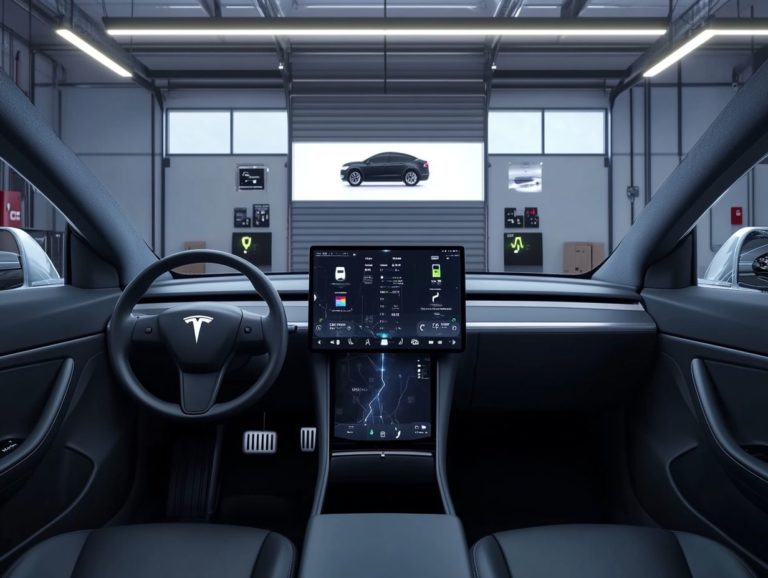How Does the Electric Vehicle Market Compare Globally?
The electric vehicle (EV) market is rapidly evolving, changing how we get around across the globe.
This overview starts with a precise definition of EVs and explores their various types. Get ready to explore exciting global trends in EV adoption, current market size, and growth projections. We will also highlight the leading countries in sales and their distinctive policies.
It’s essential to address the challenges that come with this transition, such as infrastructure limitations and consumer attitudes.
As you look ahead to the future of EVs, you will discover anticipated changes and potential disruptions.
Embark on this journey as you delve into the dynamic heart of the electric vehicle market.
Contents
- Key Takeaways:
- Overview of the Electric Vehicle Market
- Global Trends in Electric Vehicle Adoption
- Leading Countries in Electric Vehicle Sales
- Challenges and Barriers to Electric Vehicle Adoption
- Future Outlook for the Electric Vehicle Market
- Frequently Asked Questions
- What is the current state of the global electric vehicle market?
- How does the electric vehicle market compare to the traditional gasoline vehicle market?
- Which countries have the largest electric vehicle markets?
- What factors contribute to the growth of the global electric vehicle market?
- How does the cost of electric vehicles compare to traditional gasoline vehicles?
- What challenges does the global electric vehicle market face?
Key Takeaways:

- Electric vehicles are defined as any vehicle that runs on electricity, with different types such as battery-electric, plug-in hybrid, and fuel-cell electric.
- The electric vehicle market is growing globally, with a current market size of over 7 million vehicles and a projected growth of 16% annually.
- China, Europe, and the US are the leading countries in electric vehicle sales, with China holding the largest market share and implementing supportive policies.
Overview of the Electric Vehicle Market
The electric vehicle (EV) market has experienced remarkable growth over the past decade. This growth is fueled by advancements in battery technology, rising demand for zero-emission vehicles, and supportive government policies designed to reduce CO2 emissions.
As global car sales increasingly transition to electric options, you will notice a significant uptick in the market share of EVs across regions like Europe, China, and the USA, reflecting the global impact of electric vehicle adoption.
This transformation is reshaping the transportation industry and influencing consumer trends. It is also driving the expansion of essential infrastructure, such as public charging stations and smart charging technology.
Definition and Types of Electric Vehicles
Electric vehicles (EVs) run on electric power. They utilize either battery electric technology or hybrid systems.
They come in several classifications, including battery electric vehicles (BEVs), plug-in hybrids (PHEVs), and specialized electric models like buses and trucks.
Each type serves a unique purpose within the transportation landscape. BEVs rely exclusively on electric energy stored in their batteries, offering zero-emission options that are gaining traction for both personal and commercial use.
PHEVs blend conventional engines with electric propulsion, giving you the flexibility to choose between fuels based on your needs. Meanwhile, commercial electric models are tailored specifically for industry applications, such as freight and public transportation, driving a shift towards eco-friendly practices.
Together, these various electric vehicle classifications play a crucial role in reducing carbon footprints and enhancing urban mobility efficiency.
Global Trends in Electric Vehicle Adoption
Global trends in electric vehicle adoption reveal an impressive growth trajectory. Nations such as China, Norway, and Sweden are at the forefront of electric car registrations and pioneering EV policies.
As the market landscape evolves, emerging markets are starting to carve out their niche. This is propelled by the increasing demand for sustainable transportation solutions and the development of enhanced charging infrastructure.
Join us as we explore how electric vehicles are set to redefine our future!
Current Market Size and Growth Projections

The electric vehicle market is currently thriving. Growth projections indicate a robust upward trajectory fueled by surging battery demand and a significant increase in global electric car sales. Major manufacturers like Tesla, BYD, and Hyundai are scaling up production to meet consumer needs.
This expansion goes beyond mere demand; it includes advancements in battery technology, improved charging infrastructure, and supportive government regulations worldwide. Analysts foresee the market reaching unprecedented valuations in the coming years.
Sustainability concerns and a shift in consumer preferences toward eco-friendly vehicles are driving these trends. This positions the industry for remarkable progress.
The strategies employed by leading players are crucial in shaping competitive dynamics, ultimately influencing market stability and growth.
Leading Countries in Electric Vehicle Sales
Countries leading in electric vehicle sales, especially China, the USA, and several European nations like Norway and Sweden, are setting high standards for market share and regulations within the EV sector.
These nations have embraced strong EV policies that not only encourage adoption but also foster a vibrant ecosystem for electric mobility.
Examining market share and policies across leading countries reveals notable differences in electric vehicle sales strategies, consumer trends, and their environmental impact. Take Norway, for instance; it boasts impressive EV market penetration due to strong policies and enticing incentives. Meanwhile, other countries are quickly catching up.
This trend highlights the essential role of government support in shaping market dynamics. Incentives like tax breaks, subsidized charging stations, and strict emissions regulations effectively encourage a transition toward greener alternatives. Countries with minimal EV initiatives tend to see slower adoption rates, even as consumer awareness of environmental issues grows.
This analysis showcases varying levels of commitment and illustrates how effective policies can lead to reduced carbon footprints and enhanced urban air quality.
By observing these trends, you can glean valuable insights that may inform your EV strategies, whether you’re a policymaker or an industry leader looking to make an impact.
Challenges and Barriers to Electric Vehicle Adoption
Despite the increasing momentum surrounding electric vehicle adoption, several challenges still hinder widespread acceptance. You may encounter issues such as insufficient charging infrastructure, high costs, and varying consumer attitudes toward electric mobility.
Tackling these obstacles is essential for enhancing battery recycling processes and navigating the evolving regulatory landscape.
Infrastructure, Cost, and Consumer Attitudes

Infrastructure challenges, such as the availability of fast charging and public charging stations, significantly affect the cost and your attitude toward electric vehicles. Understanding these barriers is key to crafting effective EV policies that encourage broader adoption.
Without sufficient charging infrastructure, you might view electric vehicles as inconvenient or impractical, which can lead to hesitance in making a purchase. The high installation costs for this infrastructure can deter investments from both public and private sectors, creating a cycle of limited access.
Moreover, fluctuating costs of electric vehicles, influenced by battery technology and manufacturing processes, can weigh heavily on your decision-making. Innovative financing models, strategic partnerships for infrastructure development, and public incentives could reshape perceptions, paving the way for more widespread acceptance of electric mobility solutions.
Future Outlook for the Electric Vehicle Market
The electric vehicle market is on the rise. Advancements in battery technology and changing consumer preferences are driving this growth.
As electric mobility becomes more popular, you and other industry players must adapt quickly to these shifts.
Expected Changes and Potential Disruptions
Battery technology and consumer trends are set to disrupt the market. Electric car manufacturers must innovate and adjust their strategies to stay ahead.
Improvements in charging speed and eco-friendliness will change the competitive landscape. Consumers now prioritize performance, range, and environmental impact.
This shift brings both challenges and opportunities. Those who align their offerings with consumer preferences will likely thrive in this evolving market.
As charging infrastructure grows, staying agile is crucial. Be ready to embrace trends while managing regulatory pressures and consumer expectations.
Frequently Asked Questions
What is the current state of the global electric vehicle market?

The global electric vehicle market is rapidly expanding. It was valued at $162.34 billion in 2019 and is projected to reach $802.81 billion by 2027.
How does the electric vehicle market compare to the traditional gasoline vehicle market?
The electric vehicle market currently has a smaller share compared to gasoline vehicles. However, it’s expected to grow significantly in the coming years.
Which countries have the largest electric vehicle markets?
China leads the electric vehicle market, followed closely by Europe and the United States. Countries like Japan, South Korea, and Norway are also making notable progress.
What factors contribute to the growth of the global electric vehicle market?
Key drivers include the demand for eco-friendly transportation, government incentives, and advancements in technology.
How does the cost of electric vehicles compare to traditional gasoline vehicles?
Electric vehicles are generally more expensive than gasoline ones. However, as technology improves, this cost gap is narrowing.
What challenges does the global electric vehicle market face?
High initial costs and limited charging infrastructure are major challenges. Efforts are underway to make electric vehicles more accessible and appealing to consumers.






